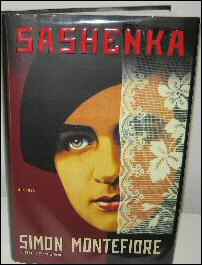Sashenka by Simon Montefiore
(New York, Simon & Schuster, 2008)
Seldom in human history has the human soul been put to trial as it was in 20th century Russia, a scorching trial that started well before the Great October Revolution and lasted till 1953 and even beyond.
Tens of millions of Russians lost their lives in the madness and randomness of the Terror, unleashed first by Lenin and vastly expanded upon later by his fiendish successor Joseph Stalin.
Many millions were shot, many millions dispatched to the icy wastelands of the Siberian Gulags after Kangaroo trials and false confessions extracted through brutal torture, many millions exiled to remote corners and many millions died in the forced famines in Ukraine and elsewhere (and we are not even including the many millions who died in World War II).
All but the most hardy perished in those hard years.
The vast majority of the victims (even the so-called Kulaks) were innocent of any crimes. Their only sin was to have been born in that benighted land.
Few Indians are aware of the great Russian tragedy of the 20th century. Back when we used to live in India, even the educated idiots were blissfully unaware or blithely dismissed our accounts of the brutality inflicted on millions in Russia as American propaganda.
In the name of an ideology called Socialism, in the cause of building a glorious Soviet nation and in the name of the great leader Stalin, countless innocent citizens were murdered and tortured, countless families torn asunder and countless children orphaned.

Sashenka – One Family’s Story
Sashenka by the historian and Stalin biographer Simon Montefiore is the fictional look at one victim family in Russia over an eight decade period.
We first encountered Sashenka’s author Simon Montefiore when we picked up his Stalin: The Court of the Red Tsar at our local Border’s store a few years ago. The biography was an awesome work and led us to borrow the prequel from our library when it came out a few years later.
So, our expectations ran very high from Sashenka.
While Sashenka has a panoramic sweep as it compresses eight decades into 511 pages, unfortunately the historical novel is no patch on Montefiore’s two majestic non-fiction works on Stalin.
The book is divided into three parts – Section One is set in 1916 before the Revolution; Section Two in 1939; and Section Three in 1994.
Disappointing
There’s much that is lacking in Sashenka.
The prose is very ordinary (compared to say a novel like The Last Witchfinder by James Morrow) and the characters, particularly the children and young adults, often speak in stilted, contrived voices.
And the background color (as in describing the surroundings of the characters or events) is frequently jarring.
Montefiore has not been able to make the leap from non-fiction to fiction without stumbling badly.
Worse, Sashenka (a real fresh strawberry, P.50) who is the central character of the first two parts of the book, never really comes to life as an extraordinary woman although the characters around her describe her as sui generis.
Truth be said, none of the characters in Sashenka soar although the story itself is not uninteresting.
Sashenka is the eponymous story of a beautiful young girl born into a rich Jewish family in St.Petersburg at the turn of the 19th century in Tsarist Russia.
Although wealthy, Sashenka, under the influence of her maternal uncle Mendel and her own wide reading, is drawn to Bolshevism at a tender age.
At great risk (remember, this is still Tsarist Russia), she actively supports the Bolshevists by distributing pamphlets and going so far as to act as a double agent.
After the revolution and as the Terror started, like most Russians of the era Sashenka too kept quiet when people all around were picked up in the dead of the night and disappeared.
The missing became non-persons.
But the bells tolled for Sashenka and her husband Vanya Palitsyn too.
Each part in the book ends at a critical moment and then begins decades later. It’d have been nice to know in detail what happened to Sashenka and her family in the interregnum, although we do get glimpses of key events later.
Putting aside all its shortcomings, we’d still recommend that you read Sashenka as an introduction to the Russian tragedy and for a peek into the horrific evil that crunched its teeth into the flesh of millions of powerless, ordinary citizens.
And as Sashenka’s life story shows us, when that evil has unfettered power, not even God (Ram, Robert, Rahim or Socialism) can save you.
Moving Bits
Sure, there are some moving accounts in Sashenka (after all, this is a 511-page tome).
Like for instance, the horrifying nature of Sashenka’s death at the hands of a bunch of depraved monsters (p.497-504).
Or when Sashenka’s lover Benya Golden tells her about his immense love for her at the shed and recites (p.266-267):
You must not lose it,
Its power is infallible,
Love gave it to you.
Or the genealogical researcher Katinka’s observation after hearing her grandfather’s rant against crooked Jews, Chechens and bureaucrats (p.372):
There was nothing to equal the burning bitterness of old men in small villages.
Or when Katinka’s friend Maxy tells her at the archives (p.401:
“Well, these are different archives. Where there is such suffering, there’s a kind of holiness. The Nazis knew they were doing wrong, so they hid everything; the Bolsheviks were convinced they were doing right, so they kept everything. Like it or not, you’re a Russian historian, a searcher for lost souls, and in Russia the truth is always not written in ink, like in other places, but in innocent blood. These archives are as sacred as Golgotha. In the dry rustle of the files you can hear the crying of children, the shunting of trains, the echo of footsteps down to cellars, the single shot of the Nagant pistol delivering the seven grams. The very paper smells of blood.”
Much as Sashenka’s story was tragic, the tragedy gets compounded when we read Montefiore mention in his acknowledgments that Sashenka’s story was, in many ways, commonplace (P.514).
As the world continues its inexorable descent into the dark ages to an uncertain future, we are increasingly turning gloomy. And so should you because who knows what varied shapes evil and tragedy will take.
After all, the evil of a few bad men and the conspiring acquiescence of many good and indifferent men brought about Sashenka.
And who said History doesn’t repeat itself.

I thought it had to something with http://www.britannica.com/EBchecked/topic/524701/Shashanka because they sounded similar
it is probably like assuming that it has something to do with Shawshank Redemption.. which inexplicably is the #1 movie on IMDB.. It was good alright.. but why is so highly ranked.
SearchIndia.com Responds:
You write above: but why is so highly ranked.
Maybe, because it’s forever showing on the free USA or TNT channels. So more people watch it.
have you read ‘The Secret History’.
It’s morbid but makes for a great read ‘cos of her writing. I think she’s a brilliant writer.
SearchIndia.com Responds:
No..we’ve been reading more of non-fiction, magazines, newspapers the last few years.
Just checked….our local library has The Secret History…will pick it up in a few days.
the ideology of stalin was communism not socialism
SearchIndia.com Responds:
What does the abbreviation U.S.S.R. stand for?
yes U.S.S.R does say socialist republic but the party of stalin and lenin was the COMMUNIST PARTY OF THE SOVIET UNION.it emerged from the bolshevik faction after they split from the mensheviks.the Bolsheviks ruled russia during stalin and lenin’s time.
SearchIndia.com Responds:
The party is called the Communist Party but the definining ideology or ism for the U.S.S.R is Socialism.
Excerpt from Wiki:
So, we’ve used socialism appropriately in the above post.
Pl see Socialism and Communism.
you are right.
i read communism on wiki. its the last stage of marx theory.stalin and lenin were still in the socialist stage. wanted to know if you think stalin was as bad as hitler. i certainly think so
SearchIndia.com Responds:
You write above: wanted to know if you think stalin was as bad as hitler
Does the difference of a few million deaths make one better than the other?
Both (Stalin and Hitler) were responsible for over 15 million deaths.
I feel bad writing this, but till now, I had no idea that Lenin and Stalin were such disgusting pieces of shit. I simply put em down in my memory as two Russian dictators. The facts you put before me are simply incomprehensible.
It takes a strong mind to write a story like Sashenka, with all the suffering imbued into it. It takes a strong mind to read it, too.
SearchIndia.com Responds:
You write above: I had no idea that Lenin and Stalin were such disgusting pieces of shit
Don’t forget Hitler.
Many summers ago, we read William Shirer’s – The Rise & Fall of the Third Reich.
If our memory is not failing us, after the jews were killed, the Nazis extracted the fat out of their bodies and made soap out of them. Even if it was not done on wide scale, the fact that it was done at all is, to use a Jewish expression, beyond the pale.
There are no limits to evil in most human beings. It’s just that most human beings do not get the opportunity or they are constrained by law, circumstances et al.